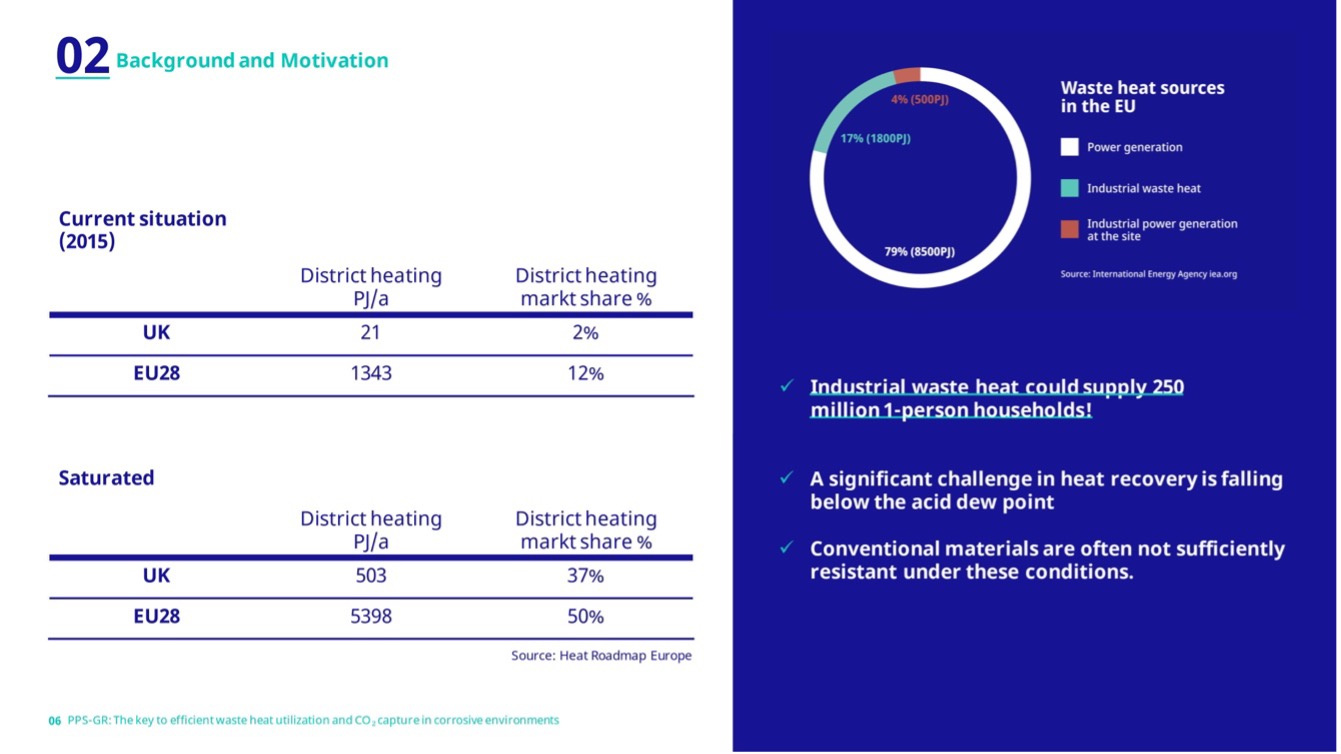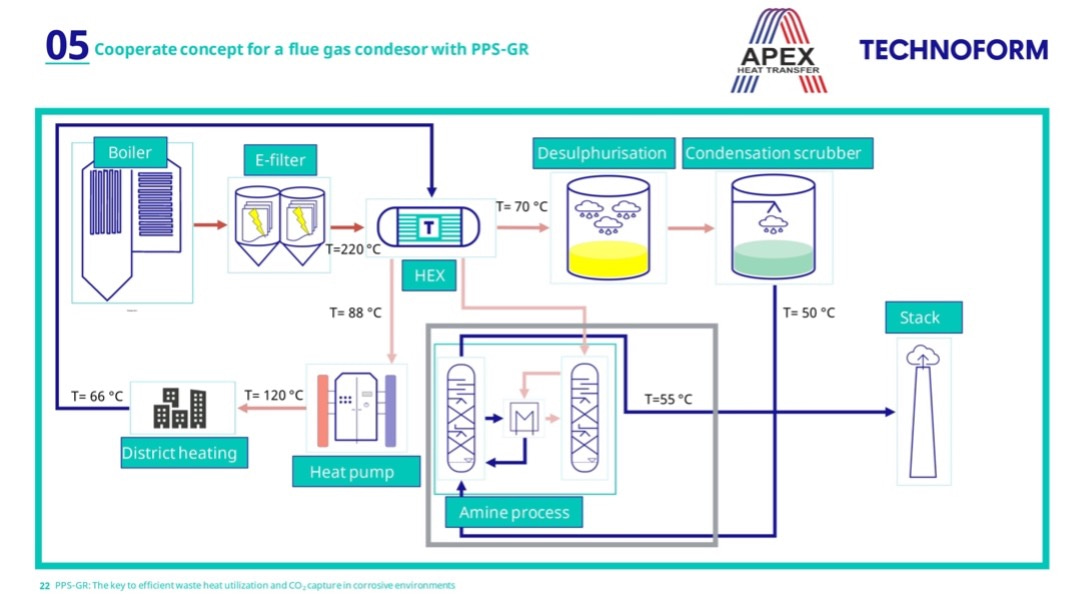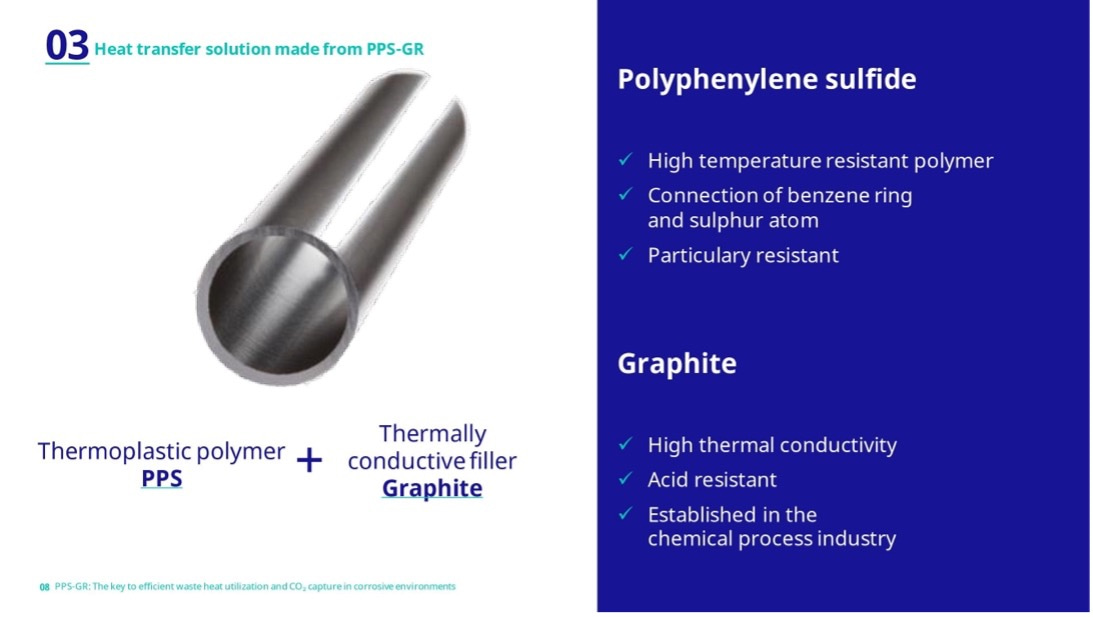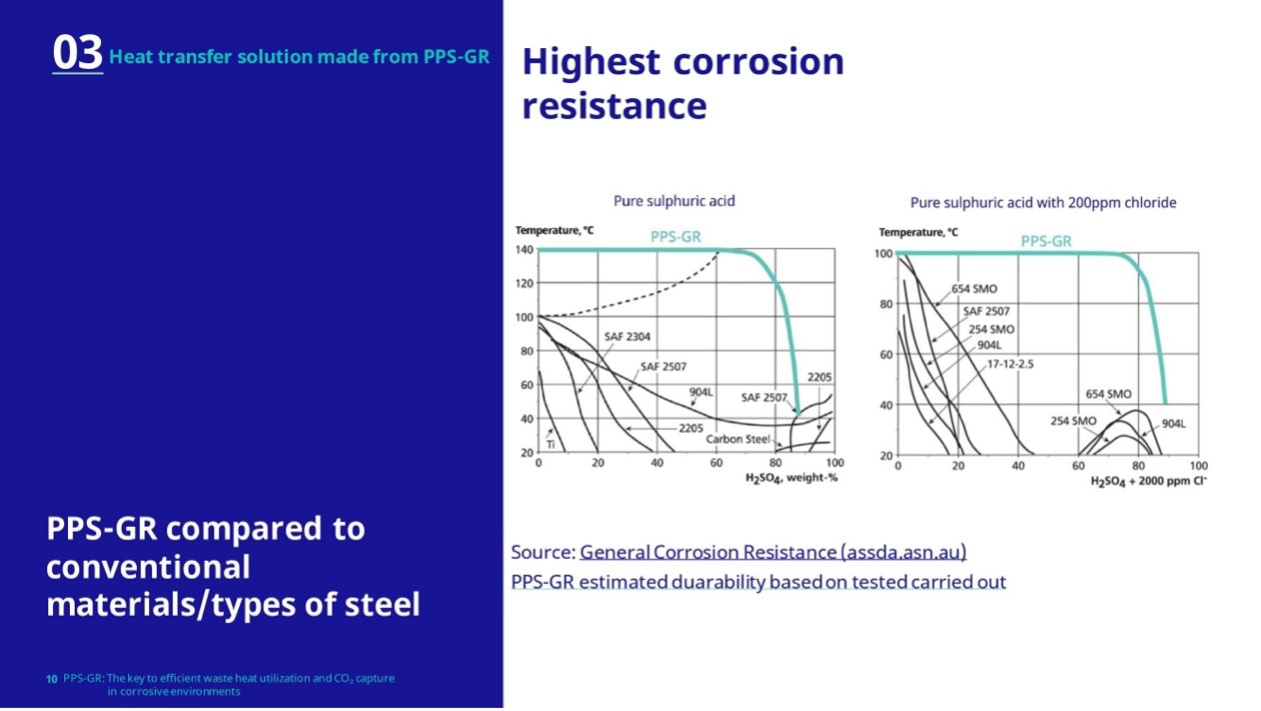PPS-GR: The Key to Efficient Waste Heat Utilization and CO2 Separation in Corrosive Environments

The Europe waste heat market was valued at USD 19.8 billion in 2022 and is set to grow strongly in the coming years (Ankit Gupta, Shashank Sisodia: 2023). Energy efficiency is the driver for economical operation. Still, massive amounts of heat remain unutilized. The corrosion resistance of polymer-based heat transfer materials enables the use of heat below the acid dew point of flue gas. Thereby, heat recovery is maximized, and additionally processed water can be produced.

Despite the shift towards renewables in Europe, most of the global energy demand is still met through combustion processes. Their efficiency and resulting primary energy consumption depends on the amount of useful energy and resources such as water that are recovered from flue gas. To fully utilize flue gas, heat needs to be extracted below the condensation point of acids. As a byproduct, the highly corrosive acids form, leading to extreme demands on heat transfer equipment used in flue gas paths.
Heat Recovery at the cold end of the plant
In combustion systems, such as power plants, waste-to-energy facilities or industrial boilers, heat exchangers play a vital role. For a long time, the status quo in these industries was to optimize heat exchangers primarily to deal with high temperatures and pressures to enable the highest possible electricity, steam and heat production.
Efficient flue gas utilization downstream of the waste heat boiler was driven at most by compliance with emission values, but without looking at the highest possible efficiency. Undoubtedly, the main reason for this was the compelling need to avoid flue gas (acid) condensation. However, in view of the ever-increasing social and political awareness of the need to reduce emissions and handle fossil fuels with care, heat exchangers are also coming to the fore for completely new types of applications:
- Waste heat recovery: Heat exchangers can recover and utilize waste heat from flue gases, boosting the overall efficiency of the combustion system.
- Emission reduction: By cooling flue gases, heat exchangers can additionally help to reduce harmful emissions.
- Condensation of water vapor: Heat exchangers can cool flue gases below their dew point, aiding in the removal of heat and pollutants.
- CO2 capture support: Lowering flue gas temperatures is vital for effective carbon capture technologies.
- Energy and cost savings: Improved thermal efficiency leads to significant energy and operational cost reductions, aligning with environmental sustainability goals.

However, the challenge arises when the temperature of the exiting flue gas is lowered below the acid dew point of 150°C. At the acid dew point, sulfuric acid, which is present in flue gas, condenses and forms a corrosive acidic condensate. This condensation can damage heat transfer surfaces, leading to mechanical failure. This issue is a significant hurdle in maximizing the efficiency of heat recovery systems. On the other hand, PPS-GR can withstand pipe wall temperatures of a maximum of 250°C, and even much higher flue gas temperatures, if the pipe wall is cooled down from the other side by water for example.
The materials of heat exchangers - especially the heat exchanger tubes - which must withstand extreme conditions, play a key role in this context. Metals are the most common materials in heat exchangers, although they are subject to erosion in corrosive environments and fail in particularly aggressive environments. This is where Technoform's PPS-GR, a graphite-polymer compound, comes into play: A new metal-free material for heat transfer surfaces with the following summarized benefits:
Outstanding resistance to acids
- Certified pressure resistance
- Greatly enhanced thermal conductivity
- Outstanding anti-fouling properties
- Adaptable tube geometry
- High precision manufacturing
- Economic efficiency
An ideal combination of stability, durability, and efficiency.
There is already an exemplary project in biogas combustion, where PPS-GR heat exchanger tubes have been proving themselves in a true test case since 2018 until today – a combination of high internal pressure, challenging temperatures, and condensation of mixed acids. Thanks to their resistance to sulfuric acid, hydrochloric acid, and hydrofluoric acid, these tubes have opened new possibilities and proved how heat sinks and sources can be efficiently coupled. The optimization of carbon capture through the targeted use of PPS-GR emphasizes the relevance of this innovative material.

A certain amount of dust and fly ashes are present in the flue gas stream. They tend to settle on the surface of heat transfer areas, building up a layer. Unless it is regularly removed, this can lead to lower heat transfer and or even clogging of the heat exchanger over time. Polymer heat transfer areas tend to have lower adhesion to these particles and can be cleaned effectively with a lower amount of water.
From an economic point of view the PPS-GR option for heat exchangers in corrosive environments is quite efficient. Tube bundle heat exchangers, which are used in waste incineration plants, require particularly thermally conductive polymer-based tubes. Technoform's solution is designed to optimize the operational uptime, minimize the investment and maintenance costs, and to provide a prominent level of safety against unexpected downtime. This is exactly what makes Technoform's heat transfer solutions, specially developed for use in corrosive environments, a long-lasting alternative to common heat exchanger materials like glass, ceramics, or steel. Our solutions are not only resistant and durable, but also stand out for their efficiency and reliability. Polymers have a high geometric flexibility, and the production is comparatively easy thanks to the melting process. It is also possible to melt down and recycle polymer-based pipes after use.
Although often used in heat exchangers, the thermal conductivity of unfilled polymer material is poor. By intelligently choosing a high proportion of an extremely thermally conductive filler such as graphite, the thermal conductivity increases dramatically, while the surface remains smooth and comparatively few deposits can adhere. The low weight of the composite material compared to solid metal pipes, offers an advantage in transport and installation. The high demand for metal on the global market is driving up the prices for metallic heat exchangers, whereas PPS-GR helps to reduce the costs.

To prevent fouling, regular chemical or mechanical cleaning is necessary, but aggressive fouling can also be prevented by pre-treating exhaust air, for example. The cleanliness of the heat exchanger has an extreme impact on the thermal conductivity of the pipe material and thus also on the efficiency of the functional process. Technoform's highly corrosion resistant solutions minimize the risk of unexpected downtime and extend the life of heat exchanger equipment. As a result, power plant operators can reduce their capital and maintenance costs while achieving outstanding performance. The heat recovery below the acid dew point opens new possibilities for flue gas utilization to effectively reduce fuel consumption and greenhouse gas emissions.
Author:
Julia Klein – Market Development Manager, Technoform Tailored Solutions Holding GmbH
+49 173 2008 422
Sources:
Ankit Gupta, Shashank Sisodia: 2023, Europe Waste Heat Recovery Systems Market Size, 2032 Report (gminsights.com)
Innovative Waermetauscher, Hans-Joerg Bart und Stephan Scholl (Hg.), 2023





Please sign in or register for FREE
If you are a registered user on Energy from Waste Network, please sign in